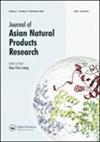Chromomycins from soil-derived Streptomyces sp. inhibit the growth of human non-small cell lung cancer cells by targeting c-FLIP
IF 1.3
3区 医学
Q3 CHEMISTRY, APPLIED
引用次数: 0
Abstract
Three chromomycin derivatives, chromomycins A3 (1, CA3), A5 (2, CA5), and monodeacetylchromomycin A3 (3, MDA-CA3), were identified from the soil-derived Streptomyces sp. CGMCC 26516. A reinvestigation of the structure of CA5 is reported, of which the absolute configuration was unambiguously determined for the first time to be identical with that of CA3 based on nuclear magnetic resonance (NMR) data analysis as well as NMR and electronic circular dichroism calculations. Compounds 1–3 showed potent cytotoxicity against the non-small-cell lung cancer (NSCLC) cells (A549, H460, H157-c-FLIP, and H157-LacZ) and down-regulated the protein expression of c-FLIP in A549 cells. The IC50 values of chromomycins in H157-c-FLIP were higher than that in H157-LacZ. Furthermore, si-c-FLIP promoted anti-proliferation effect of chromomycins in NSCLC cells. In nude mice xenograft model, 1 and 2 both showed more potent inhibition on the growth of H157-lacZ xenografts than that of H157-c-FLIP xenografts. These results verify that c-FLIP mediates the anticancer effects of chromomycins in NSCLC.
源自土壤的链霉菌的色霉素通过靶向 c-FLIP 抑制人类非小细胞肺癌细胞的生长。
从源于土壤的链霉菌 CGMCC 26516 中鉴定出三种铬霉素衍生物,即铬霉素 A3(1,CA3)、A5(2,CA5)和单去乙酰铬霉素 A3(3,MDA-CA3)。报告对 CA5 的结构进行了重新研究,根据核磁共振数据分析以及核磁共振和电子圆二色性计算,首次明确确定其绝对构型与 CA3 相同。化合物1-3对非小细胞肺癌(NSCLC)细胞(A549、H460、H157-c-FLIP和H157-LacZ)具有很强的细胞毒性,并能下调A549细胞中c-FLIP的蛋白表达。铬霉素在H157-c-FLIP中的IC50值高于在H157-LacZ中的IC50值。此外,si-c-FLIP还能促进铬霉素在NSCLC细胞中的抗增殖作用。在裸鼠异种移植模型中,1和2对H157-lacZ异种移植细胞生长的抑制作用均强于H157-c-FLIP异种移植细胞。这些结果验证了c-FLIP介导了铬霉素在NSCLC中的抗癌作用。
本文章由计算机程序翻译,如有差异,请以英文原文为准。
求助全文
约1分钟内获得全文
求助全文
来源期刊
CiteScore
3.20
自引率
5.90%
发文量
47
审稿时长
2.3 months
期刊介绍:
The Journal of Asian Natural Products Research (JANPR) publishes chemical and pharmaceutical studies in the English language in the field of natural product research on Asian ethnic medicine. The journal publishes work from scientists in Asian countries, e.g. China, Japan, Korea and India, including contributions from other countries concerning natural products of Asia. The journal is chemistry-orientated. Major fields covered are: isolation and structural elucidation of natural constituents (including those for non-medical uses), synthesis and transformation (including biosynthesis and biotransformation) of natural products, pharmacognosy, and allied topics. Biological evaluation of crude extracts are acceptable only as supporting data for pure isolates with well-characterized structures.
All published research articles in this journal have undergone rigorous peer review, based on initial editor screening and anonymized refereeing by at least two expert referees.

 求助内容:
求助内容: 应助结果提醒方式:
应助结果提醒方式:


